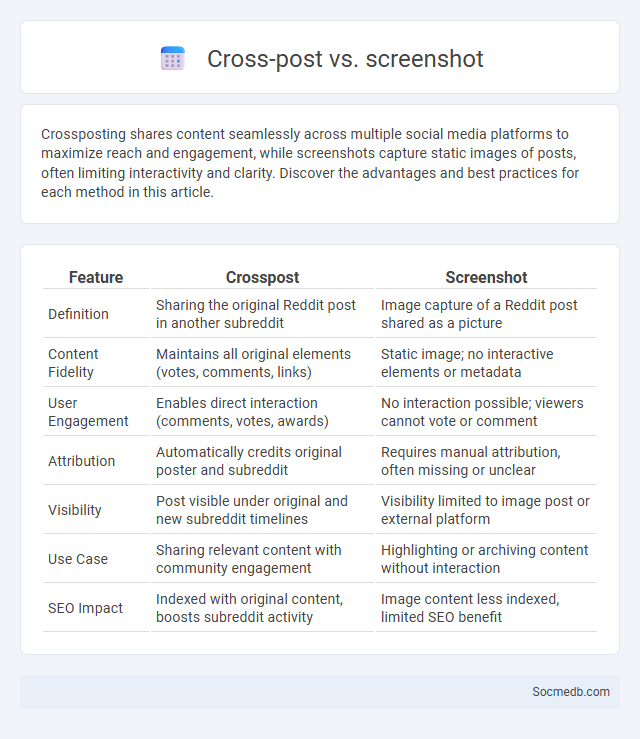
Photo illustration: Crosspost vs Screenshot
Crossposting shares content seamlessly across multiple social media platforms to maximize reach and engagement, while screenshots capture static images of posts, often limiting interactivity and clarity. Discover the advantages and best practices for each method in this article.
Table of Comparison
| Feature | Crosspost | Screenshot |
|---|---|---|
| Definition | Sharing the original Reddit post in another subreddit | Image capture of a Reddit post shared as a picture |
| Content Fidelity | Maintains all original elements (votes, comments, links) | Static image; no interactive elements or metadata |
| User Engagement | Enables direct interaction (comments, votes, awards) | No interaction possible; viewers cannot vote or comment |
| Attribution | Automatically credits original poster and subreddit | Requires manual attribution, often missing or unclear |
| Visibility | Post visible under original and new subreddit timelines | Visibility limited to image post or external platform |
| Use Case | Sharing relevant content with community engagement | Highlighting or archiving content without interaction |
| SEO Impact | Indexed with original content, boosts subreddit activity | Image content less indexed, limited SEO benefit |
Introduction: Understanding Content Sharing Methods
Content sharing on social media involves various methods such as posting, reposting, and direct messaging, enabling users to distribute information quickly and broadly. Platforms like Facebook, Instagram, Twitter, and TikTok utilize algorithms that prioritize engaging content, increasing visibility based on user interactions. Effective content sharing strategies leverage multimedia formats including images, videos, and links to maximize audience reach and engagement.
What is Crossposting?
Crossposting is the practice of sharing the same content across multiple social media platforms to maximize reach and engagement. You can streamline your marketing efforts by posting once and distributing it seamlessly to networks like Facebook, Instagram, Twitter, and LinkedIn. This approach increases content visibility while maintaining consistency in your brand messaging.
What is a Screenshot Post?
A screenshot post is a type of social media content that involves capturing and sharing an image of content displayed on a screen, such as messages, tweets, or articles. These posts provide a visual representation of digital interactions or information, often used to highlight conversations, reactions, or notable content. Screenshot posts are popular for their authenticity and ability to preserve and share specific moments or statements within various social media platforms.
Key Differences Between Crossposting and Screenshotting
Crossposting involves sharing the same content across multiple social media platforms simultaneously, maximizing reach and maintaining content consistency, while screenshotting captures static images of content, often leading to lower quality and reduced engagement. Crossposting supports analytics tracking and audience targeting through native platform tools, whereas screenshotting bypasses these metrics and can potentially violate original content rights. Brands leveraging crossposting benefit from streamlined content management and unified messaging, contrasting with the informal and less controlled nature of screenshot sharing.
Pros and Cons of Crossposting
Crossposting on social media allows you to efficiently share content across multiple platforms, increasing your reach and saving time on content creation. However, it can lead to reduced engagement due to platform-specific audience preferences and content formats, which may cause your posts to appear less authentic. Balancing your strategy by tailoring posts to each social network improves user interaction and maintains your brand's relevance.
Pros and Cons of Screenshot Sharing
Screenshot sharing on social media facilitates quick and easy dissemination of information, enabling users to capture and share moments, messages, or content without needing original files. However, this practice poses privacy risks and potential misuse, as sensitive information or private conversations can be exposed without consent. It also challenges intellectual property rights, as shared screens may distribute copyrighted or misleading content without proper context or attribution.
Legal and Ethical Considerations
Social media platforms must navigate complex legal frameworks including data privacy laws like GDPR and intellectual property rights to protect users and content creators. Ethical considerations involve combating misinformation, ensuring transparent algorithms, and preventing harassment and discrimination to foster a safe and inclusive online environment. Companies face increasing pressure to implement rigorous content moderation policies that balance freedom of expression with legal accountability.
Engagement and Reach: Which Performs Better?
Engagement measures how actively users interact with your content through likes, comments, shares, and clicks, indicating deeper connection and loyalty. Reach quantifies the total number of unique users who see your content, reflecting brand visibility and awareness. For your marketing strategy, prioritizing engagement often delivers better long-term benefits by fostering a dedicated audience, while reach is essential for expanding potential customer pools quickly.
Platform Policies: What Do Major Sites Allow?
Major social media platforms enforce distinct policies regulating content such as hate speech, misinformation, and user behavior to ensure safe digital environments. Facebook permits political ads but requires transparency, while Twitter restricts misleading information, especially concerning elections and health. Instagram emphasizes community guidelines against bullying and harmful content, consistently updating rules to address emerging issues like deepfakes and harassment.
Choosing the Right Method for Your Content Strategy
Selecting the optimal method for your content strategy on social media hinges on understanding platform-specific algorithms and audience behaviors. Tailoring content formats such as videos, infographics, or articles to match user preferences on channels like Instagram, LinkedIn, or TikTok boosts engagement metrics and reach. Data-driven analysis of performance insights enables continuous refinement, ensuring content resonates effectively and drives measurable results.
 socmedb.com
socmedb.com